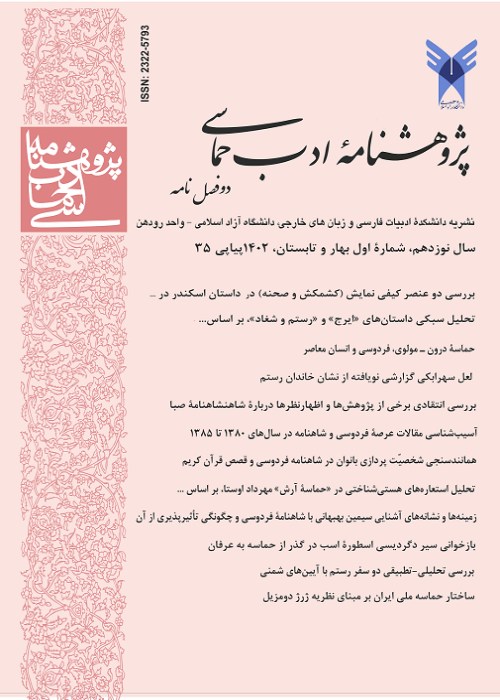The study of narrative grammar in the tale of Rostam and Esfandyar based on the Greimas narrative theory
Author(s):
Article Type:
Research/Original Article (دارای رتبه معتبر)
Abstract:
Structural analysis of literary works due to the study of intertextual elements and the discovery of their overall pattern leads to a better understanding of the literary works and with the help of the results obtained from such analysis one can unravel the mysteries underlying the creation of different works and discover the appropriate patterns for their analysis. One of the methods to analyze the structure of literary works is the Greimas narrative model. The application of the processes and narratological, semiotic, and semantic patterns that Greimas propose in order to recognize the overall structure of a narrative and also the analysis of Persian texts whether in prose or verse seems an essential task. Casting a critical look over variety of texts in search of meaning either to prove or disprove the patterns could entail significant results. Many tales in Shahnameh were investigated according to Grimas theory. A number of these tales include manifestations of magic and sorcery and in this regard numerous studies had been conducted, yet till present a research regarding the grammar of magic narrative in Shahnameh had not been conducted The purpose of this article is to study the structure of the plot, to analyze the active patterns, to recognize the mechanisms and the elements involved for production of meaning in the magic and sorcery narrative in the tale of Rostam and Esfandyar, and to study the impact of magic on the structures of this narrative. The conclusion drawn from the research show that where ever in Shahnameh tales inhuman, magic actors are involved they play the major role in forming the tale and moving it forward leaving the human actors behind. In fact a particular grammar gets created for the works concerning magic. The discovery and identification of this kind of grammar and unique characteristics of the author’s style could help researchers verify the attributions given to the author of the literary work.
Keywords:
Language:
Persian
Published:
The Journal of Epic Literature, Volume:18 Issue: 1, 2022
Pages:
177 to 196
magiran.com/p2473342
دانلود و مطالعه متن این مقاله با یکی از روشهای زیر امکان پذیر است:
اشتراک شخصی
با عضویت و پرداخت آنلاین حق اشتراک یکساله به مبلغ 1,390,000ريال میتوانید 70 عنوان مطلب دانلود کنید!
اشتراک سازمانی
به کتابخانه دانشگاه یا محل کار خود پیشنهاد کنید تا اشتراک سازمانی این پایگاه را برای دسترسی نامحدود همه کاربران به متن مطالب تهیه نمایند!
توجه!
- حق عضویت دریافتی صرف حمایت از نشریات عضو و نگهداری، تکمیل و توسعه مگیران میشود.
- پرداخت حق اشتراک و دانلود مقالات اجازه بازنشر آن در سایر رسانههای چاپی و دیجیتال را به کاربر نمیدهد.
In order to view content subscription is required
Personal subscription
Subscribe magiran.com for 70 € euros via PayPal and download 70 articles during a year.
Organization subscription
Please contact us to subscribe your university or library for unlimited access!


